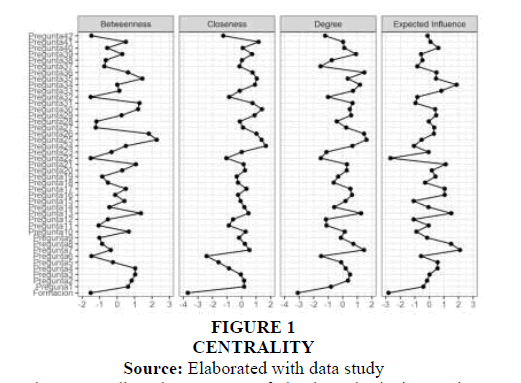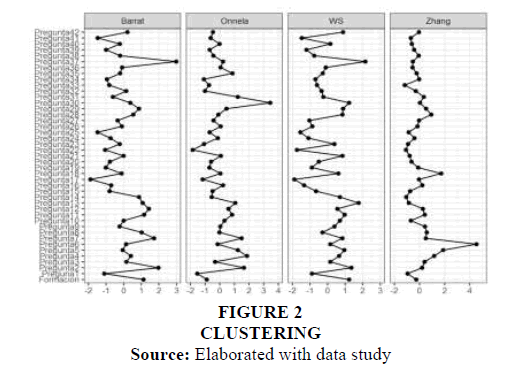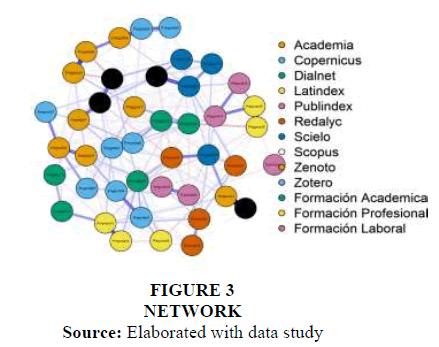Research Article: 2023 Vol: 22 Issue: 2
Intellectual capital formation networks in the COVID-19 era
Francisco Espinoza Morales, University of Sonora
Cruz García Lirios, Autonomous Mexico State University
Citation Information: Morales, F.E., & Lirios, C.G. (2023). Intellectual Capital Formation Networks in the Covid-19 Era. Journal of International Business Research, 22(2), 1-7.
Abstract
The objective of this paper was to specify a model for the study of intellectual capital formation. A documentary, retrospective and exploratory study was carried out with a selection of sources indexed to international repositories, considering the period from 2019 to 2022, as well as the search by keywords. The axes, themes, dimensions and categories of discussion were established in the research agenda, suggesting the extension of work towards other scenarios such as training and training.
Keywords
Institutionalism, Agenda, Entrepreneurship, Talents, Formation.
Introduction
Until March 2022, the pandemic has claimed the existence of seven million directly through the spread and disease of COVID-19 (WHO, 2022). In an indirect way, affecting comorbidities such as diabetes or hypertension, it would be related to 20 million deaths (PAHO, 2022). Anti-COVID-19 policies in education are distinguished by replacing the traditional classroom with a virtual one (OCDE, 2022). The epidemiological traffic light determines the transition: in red, the educational systems withdraw, the confinement intensifies and the interaction is reduced to virtual platforms; in green, universities and institutes design hybrid teaching and learning systems (SSA, 2022). Underlying this phase of lack of confidence is the formation of intellectual capital as a liaison policy between universities and knowledge-creating organizations.
Intellectual capital refers to a series of academic and professional training requirements that allow a more direct transition from the university to the labor market, mainly employment opportunities in the locality. In this sense, the intellectual capital review works have focused their interest in the formation of habitus understood as the transfer of knowledge, skills and wisdom of the professional to the student.
In this way, the works related to the formation of the intellectual habitus have demonstrated a virtuous circle of trust, commitment, entrepreneurship, innovation and satisfaction (Ardevol, 2015). It is an academic and professional training focused on the climate of relationships, tasks and conflicts.
However, systematic reviews and metanalysis related to intellectual capital have focused on performance, productivity and competitiveness without considering this training process. In this sense, a review of the training process of intellectual capital will establish the axes, themes, dimensions and categories.
Theory of Intellectual Capital Formation
The formation of intellectual capital involves phases of management, production and transfer of knowledge (Carreon et al., 2019). This is the case of professional training in companies located in the Silicon Valley, Palo Alto, California, United States. It is a process in which the creation of an innovation is driven by risk capitals that increase as the original idea is consolidated and adjusts to the current and future requirements of a real or potential market.
In the process of intellectual capital formation, it involves consolidating intangible assets of organizations financed with venture capital. Management is simple when compared to the consolidation of the entrepreneurial project or the production of new knowledge, as well as the transfer of this knowledge to other areas of the subsidiary or subsidiary organizations or companies of the main parent company.
The theory of intellectual capital formation warns that such complexity would not be possible without inherited or acquired knowledge teaching (Garcia, 2020). It is a training habit in which expressions; knowledge, values and appreciations are transferred in academic, professional and labor training.
These four dimensions related to ethos, aesthesis, hexis and eidos form a formative habitus that is gestated in the interrelation of provisions against or in favor of a project; opportunity generation, resource optimization or process innovation (Korstanje, 2020).
Studies of Intellectual Capital Formation
Research related to training habitus highlights the convergence of the four aesthetic, expressive, cognitive and ethical dimensions in the production of knowledge (Clark, 2020). If the management of each of them involves the translation of these four dimensions into objectives, tasks and goals, then the production of knowledge will start from personal dispositions and will culminate with the consolidation of distinctive features of the innovative product or process. That is, technology is a reflection of the academic, professional and labor relations involved in the management, production and transfer of knowledge.
Consequently, the measurement of this formative process of intellectual capital has been very complex (Villegas, 2018). Some instruments focus their interest in entrepreneurship; considering the creation of opportunities, the optimization of resources or the innovation of processes as central axes. Other works refer more to the particular analysis of academic, professional or occupational training, focusing their analysis on the translation of knowledge, experiences and emotions.
However, the formation of human capital is focused on the transfer of knowledge that allows the consolidation of projects and the conversion of talents into intangible assets. That is, emotions, values, expressions and knowledge transferred towards the convergence of objectives, tasks and goals as entrepreneurship or innovation devices.
Modeling of Intellectual Capital Formation
From the formative theory of the intellectual capita and the studies on the relations between its dimensions and components in the academic, professional and labor field, it is possible to delineate trajectories of relations between the categories and variables.
The first trajectory of the academic, professional and labor habitus explains the transfer of knowledge prior to management and production oriented to the consolidation of projects outlined in this path. This is the case of innovations that originated among students and consolidated among competitors, as is the case of information and communication technologies.
The second route refers to the process of management, production and transfer of knowledge complementary to the first route since it involves the insertion of risk capital. The same innovative project of information or communication technology is potentialized with venture capital to intensify the consolidation of the project.
A third peripheral route to the previous two refers to the process of knowledge transfer and its culmination in a production of knowledge. This is the case of strategic alliances between universities and organizations that, through professional practices to social services, will generate an agenda for the translation of ideas and their concatenation.
Objective: Discuss the axes, themes, dimensions and categories of the intellectual training agenda in order to evaluate the public policies of strategic alliances between higher education institutions and knowledge-creating organizations for graduation and market insertion labor.
Formulation: Will there be differences between the axes, themes, dimensions and categories reported in the public literature from 2019 to 2022?
Null hypothesis: There will be no significant differences between the axes, themes, dimensions and categories reported in the literature related to the formation of intellectual capital.
Method
Design: Documentary, retrospective and exploratory study
Sample: Selection of sources indexed to international repositories such as; Academia, Copernicus, Dialnet, Latindex, Publindex, Redalyc, Scielo, Scopus, Zenodo and Zotero, considering the period of publication from 2019 to 2022, as well as the search for "intellectual capital" keywords Table 1.
| Table 1 Descriptive Of Sample |
||||
|---|---|---|---|---|
| 2019 | 2020 | 2021 | 2022 | |
| Academia | 6 | 5 | 5 | 2 |
| Copernicus | 5 | 4 | 4 | 3 |
| Dialnet | 8 | 6 | 3 | 4 |
| Latindex | 7 | 7 | 7 | 1 |
| Publindex | 6 | 5 | 5 | 2 |
| Redalyc | 5 | 3 | 2 | 3 |
| Scielo | 6 | 5 | 2 | 2 |
| Scopus | 4 | 4 | 5 | 3 |
| Zenodo | 3 | 7 | 6 | 1 |
| Zotero | 4 | 8 | 6 | 1 |
Source: Elaborated with data study.
Instrument: Matrices of content analysis, opinion and contingency. They include columns of selected findings from the literature, qualifications, feedback and reconsiderations of experts in the field.
Process: The summaries were selected from the search by keywords of intellectual capital formation, considering the period of publication from 2019 to 2022. Expert judges rated the summaries, considering; -1 for the intellectual formative process detached from the university with the labor market, 0 for the training process without significant effects and 1 for positive effects of the training process (Harper, 2012). Then, the results were presented in order to obtain opinions to provide feedback on the criteria (Sharma & Jain, 2013). Once the ratings and feedback were combined, the differences and coincidences for the reconsiderations and consensus were established (McCleskey, 2014). The data was processed in the qualitative analysis package version 3.0 Table 2.
| Table 2 Description Of The Judges |
|||
|---|---|---|---|
| Sex | Age | Income | Experience |
| Male | 57 | 47’324.00 | 20 |
| Female | 68 | 53’902.00 | 30 |
| Female | 54 | 43’423.00 | 21 |
| Female | 61 | 38’564.00 | 32 |
| Male | 48 | 28’546.00 | 20 |
| Male | 55 | 42’436.00 | 30 |
| Male | 49 | 51’982.00 | 20 |
Source: Elaborated with data study
Analysis: Prevalence distribution parameters were estimated in order to establish the prevalence of axes, themes, dimensions and categories related to the formation of intellectual capital (de la Fuente, et al., 2012). The contingency and proportion statistics were weighted to test the null hypothesis.
Results
Figure 1 show the prevalence of the axes alluding to the inter-institutional of intellectual capital is led by strategic alliances (66%) between higher education institutions and local labor market organizations; being the subject of professional practices (51%) the dominant one, as well as the dimension of knowledge management (40%) and the hegemonic category of habitus (51%).
Figure 2 show regarding the contrast of the hypothesis in contingent relationships, institutional coupling [?2=13,21 (23 df) p < 0,5], professional practices [?2=14,21 (19df) p < ,05], translation of experiences [?2=15,32 (18df) p < ,05] and provisions [?2=16,21 (17df) p < ,05] were not rejected.
Figure 3 show regarding the proportional relationships of probability, institutional isomorphic was related to professional practices [OR=23, 21 (13, 28 to 45,30)] and the translation of knowledge with the provisions [OR=18,21 (19,21 to 30,28)].
Discussion
The contribution of the present work to the state of the matter lies in the exploration of the axes, themes, dimensions and categories related to the formation of the intellectual capital, although the research design limited the results to the repositories that house the consulted literature, suggesting the extension of work to other contexts such as training and training.
In relation to the academic training that highlights professional competences, the present work has demonstrated an axis of institutional coupling whose rectory determines the strategies of alliances between universities and organizations. In this sense the isomorphism of the programs and strategies of alliances will allow the observation of the differences and similarities between the educational and labor actors (Melchar & Bosco, 2010).
With respect to labor practices as an area of professional competences, the present study warns that these topics are contingent on the coupling of the university with the labor market. In this way, lines of research related to strategic alliances will allow the unveiling of management competencies rather than production and transfer of knowledge.
This is because the transfer of experiences was related to the dispositions to professional learning. It is a scenario in which strategic alliances and professional practices involve a transfer of knowledge for vicarious learning rather than for the contrast of theories (Rivera et al., 2013).
Regarding the systematic reviews and meta-analysis of the formation of intellectual capital that highlights the prevalence of strategic alliances Sánchez et al. (2011), collaborative practices Weaver (2007) and the implementation of new technologies (Wepner, 2012) for a 4.0 training, this study suggests that this technological axis is complemented by a dispositional axis of teaching and learning between the parties involved.
Conclusion
The objective of this work was to specify a model for the study of the formation of intellectual capital, emphasizing the dimensions of coupling between institutions and actors, as well as in relation to professional practices, translation of experiences and dispositions to learning.
These contributions are complementary to the literature reviews published from 2019 to 2022, although they disagree regarding the relationships between the axes, themes, dimensions and established categories. Research lines concerning the theoretical and conceptual frameworks that explain such relationships will allow us to test hypotheses related to case observations in management, production and knowledge transfer scenarios.
References
Ardevol, A. (2015). Framing theory in communication research. Origins, development and current situation in Spain. Latina Magazine of Social Communication, 70, 423-450.
Carreon, J., Fierro, E., & García, C. (2019). Models of fixed effects of diffuse variables in the formation of intellectual capital. International Journal of Engineering Research and Development, 15(9), 1-7.
Clark, S. (2020). Specification a model of intellectual capital. International Journal of Economics & Management Studies, 10(3), 1-3.
de la Fuente, J., Vera, M.M., & Cardelle-Elawar, M. (2012). Contributions to education from the Psychology of Innovation and Entrepreneurship, in today’s Knowledge Society. Electronic Journal of Research in Educational Psychology, 10(3), 941-966.
Garcia, C. (2020). Specification a model for study of entrepreneurship. Advances Research Journal of Multidisciplinary Discoveries, 49 (1), 1-4.
Harper, S. (2012). The leader coach: a model of multi style leaderships. Journal of Practical Consulting, 4 (1), 22-31.
Korstanje, M.E. (2020). Academic framework of knowledge management. International Journal of Engineering Technology and Management Research, 7 (2), 1-6.
McCleskey, J.A. (2014). Situational, transformational, and transactional leadership and leadership development. Journal of business studies quarterly, 5(4), 117.
Melchar, D.E., & Bosco, S. M. (2010). Achieving high organization performance through servant leadership.
Rivera, D., Punin, M., & Calvo, D. (2013). Agenda setting in the Ecuadorian press: The Universe, The Mercury, The Commerce and The Telegraph. Latina Magazine of Social Communication, 68, 209-244.
Sánchez, J., Cagiano, V.,& Hernández, V. (2011). Entrepreneurship competencies in university education. International Journal of Developmental and Educational Psychology, 1 (2), 19-28.
Sharma, M.K., & Jain, S. (2013). Leadership management: Principles, models and theories. Global Journal of Management and Business Studies, 3(3), 309-318.
Villegas, E. (2018). Specification a model of intellectual capital. International Journal of Economics & management Studies, 10 (1), 1-2.
Weaver, D.H. (2007). Thoughts on agenda setting, framing, and priming. Journal of communication, 57(1), 142-147.
Wopner, F. (2012). Entrepreneurship as a factor of social mobilization.
Received: 27-Feb-2023, Manuscript No. JIBR-23-13274; Editor assigned: 01-Mar-2023, Pre QC No. JIBR-23-13274(PQ); Reviewed: 15- Mar-2023, QC No. JIBR-23-13274; Published: 22-Mar-2023


